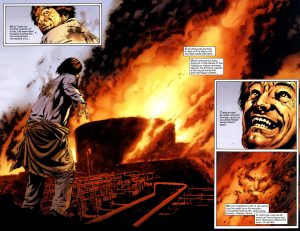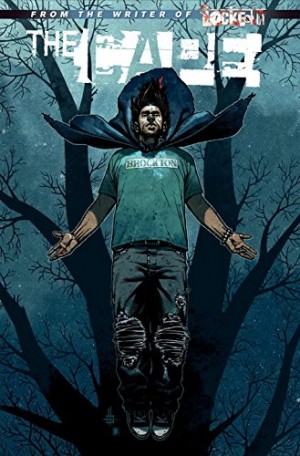Review by Ian Keogh
All too often graphic novels adapting prose works are an unsatisfactory experience. The adage of a picture being worth a thousand words barely applies. The Stand, therefore, should provide the benchmark, the gold standard of how to do this properly. It’s not rocket science either, but requires some investment. Instead of attempting to compress over 800 pages of novel into somewhere between 50 and 100 pages, and in doing so losing nuance and plot details, Marvel invested in the creative team of adapter Robert Aguirre-Sacasa and artist Mike Perkins, the pair responsible for every page here. They worked on the project for over two years, and can be justifiably proud of the result.
Stephen King has written over fifty novels, yet it’s the fifth, The Stand that most consistently tops the list of his highest ranked works. It differs from much of his other work, not least because the opening horror is man-made, a disease wiping out over 99% of the American population, and the lengths justified by the authorities in avoiding culpability. For much of the time it’s a work of post-apocalyptic fiction, as survivors gather in small groups, and the supernatural elements are surprisingly restrained. King takes time to build a substantial number of characters, and is unsentimental about them, using them to investigate themes of belief, fate, and survival.
This is all transferred in a first class manner. Aguirre-Sacasa re-jigs plot elements slightly, aware that a graphic novel has different sensibilities, particularly when originally serialising in segments as thirty chapters, each requiring some form of cliffhanger ending to generate interest in the following sequence. Perkins is superb throughout, his naturalistic style bringing cast and location to life and the copious background notes show just how much thought he’s put into certain scenes. A key suspenseful sequence occurs in the Lincoln Tunnel, connecting New York with the mainland, and without power after the disaster. Aguirre-Sacasa and Perkins convey the tension superbly. The character designs are also notable. It might be expected that Trashcan Man, Randall Flagg and Harold Lauder would stand out, but Perkins ensures we can differentiate between the more normal cast members also.
For those unfamiliar with the plot, it’s a character-rich story first concerning how humanity survives after disaster, the lead characters gradually coming together. It’s then apparent that everyone is either drawn to Mother Abigail in Boulder, or the malign Flagg in Las Vegas, led primarily by their personality, but then by dreams and faith. A second apocalypse seems high on the agenda. It’s a substantial work with some weighty themes, and compelling throughout.
Rather than separating chapters with the background material accompanying the original comics, it’s been collected into its own hardcover The Stand Companion, snugly fitted into the slipcase. It’s frequently enlightening, but when gathered into one volume it’s also repetitive, although some may want to see exactly how a script translates into finished pages a dozen times.
This is substantially more expensive that other Marvel Omnibus editions, so while it’s an adaptation to cherish, you may prefer the individual graphic novels. Reviews of all six can be found starting with Captain Trips. If you can afford this, however, you might want to consider one step further and purchasing some of the original art by Perkins here.





